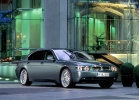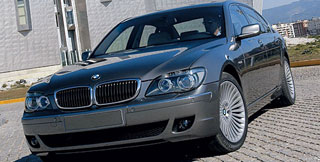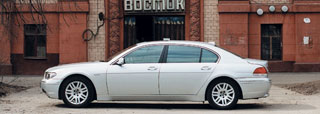Test drive BMW 7 E65 E66 2001 - 2005 sedan
Black Raven
Talking about representative cars, especially the latest models, is always incredibly difficult. Almost everything that normal models is considered additional equipment, for representatives of this class, long ago is in the database. The price that can cause shock in an unprepared person, the size, fuel consumption, the quality of the materials used - everything is erected to an absolute degree. Yes, there is also a pedigree. Each car manufacturer producing the highest class model has its position in this tablet tables, and strangers in this club on interests are allowed to say extremely reluctantly, if not more.The latest BMW of the seventh series, which will be discussed today, is far from a beginner in this class - this is the fourth generation of limousines with a propeller on a false radiator lattice. But if all previous models were primarily BMW, and only then a representative limousine, then the current, perhaps the most revolutionary in the history of the company, was originally developed precisely as a top model in the class of representative limousines. Although the drivers in the character of the new model remained too ...
One of the most striking features characterizing the representative BMW of the previous years was incredibly sophisticated, as if in a fighter, a dashboard and a central console. Many buttons, handles and keys, some devices and indicators - all this made no less impression on the inhabitants than the machine itself and its characteristics. Time passed, and with each generation the seven surrounded everything with new and new bells and whistles, most of which were controlled directly from the driver's seat. Accordingly, the number of controls increased: climate control, electric drives, various heating and blowing, etc. ..
In general, the fourth generation, stuffed with various service devices, should have simply become indicative in this regard, because it is simply impossible to place control keys for more than 700 service devices on one panel. Even if you purely theoretically consider such an opportunity, then the first association that comes to mind is a Japanese watch with a calculator, where the buttons need to be pressed with a match. Naturally, this option is not suitable for BMW, so the main problem for developers of the fourth -generation seven was the placement of all controls at hand, but so that the driver always accurately gets to the desired key and is not distracted from the road. The task is the most difficult, but a brilliant exit was found - a system called I -Drive, is really capable of managing all service devices available on board.
The control principle is simple: the circus-shaftls located on the central console performs functions similar to the computer mouse, only the algorithm of its operation is slightly different. In the initial menu, where all service devices, depending on the purpose, are divided into several groups, you just need to pump the shuttle towards the desired inscription. Further, almost like in a computer: the choice of a particular function occurs by rotating the shuttle, and its inclusion/off is by pressing it. Depending on what the parameters of which you change, the efforts on the controller increase or decrease: the farther from the position of zero, the more the shuttle resists. At the same time, if you just look at the menu, then the efforts on it are minimal. It is simple, and most importantly - all the functions are concentrated on one control organ, so you do not have to look for the eyes on the panel, wondering: where could this button put? And I-Drive controls, as I have already said, almost all the functions that are a great many in the car. And if the BMW was previously famous for the presence of a huge amount of electronics, then in the new seven electronics controls everything. Well, or almost everyone.
The brake system has not yet been made completely electronic, and the steering, despite the presence of an amplifier, is still obeying the driver's teams. But everything that does not directly refers to the driving process is necessarily controlled by electronics - in total, 85 electric motors are installed in the car! Of course, we will not be able to list all the options installed in this car, otherwise the article will turn into a large list, but you can name the most interesting ones.
We will not even speak about ABS, climate control with the possibility of separating flows, electric drives of mirrors and glass windows - in the new century all this is already too trivial. You can not talk about the running qualities of new cars: to date, the equipment has reached such a level that, depending on the need, you can get any suspension settings, especially if there is appropriate experience in this matter. And BMW has it: Bimmers have always been famous for their running qualities, even the seven, which dashing grabs are contraindicated in status. Yes, and we will now have to talk about the running qualities of the new seven with one reservation: by order this car can be equipped with an adjustable suspension. And this means that with the help of the same I-Drive you can completely change the characteristics of the pendants directly on the move, having achieved either unquestioning obedience to the steering wheel and excellent controllability or smoothness. Unfortunately, there was no such option on the tested car, so we will leave the acquaintance with this suspension for later.
Inside, the seven has changed even more than outside. There was practically nothing left of previous generations except the propeller on the steering wheel. The lever of the checkpoint of the checkpoint migrated to the sheepskin region, the entire architecture of the salon changed, archaic switch devices were replaced by a modern vacuum-luminescent panel. By the way, with regard to the convenience of management, the ergonomics of the salon only won from these permutations. Even having spent only a few hours in the cabin, you can make sure how much more convenient and friendly the car has become.
It has become much more convenient to use the steering wheel lever, switching from R to D you can without taking off your hands from the steering wheel, and return to Parking in general with one movement of your finger, because there is an appropriate button on the end of the lever. The handbrake, by the way, is also very unusual in the seven. There is no traditional lever on the central tunnel, as there is no special pedal on the floor. It turns on by pressing the button located to the left of the steering wheel, and automatically turns off when the pedal is touched (if the machine was on the transmission).
By the way, such a handbrake can be used even for emergency braking. If the main brake system refused, which is very, very unlikely, the handbrake can stop the car itself, while using the absorbers of the ABS. But the creators of the new seven even seemed to be few, so in addition to the above functions, they added one more.
The Automatic Hold function, which in Russian can be called approximately as an automatic parking brake, is also turned on through the I-Drive menu. The essence of her work is simple: as soon as the car stopped, or by your will, it will stand until the driver again turns on the program and clicks on the gas. And it doesn’t matter at all, on the slope or on a flat surface there is a car: by stopping the car, you can immediately release the brake pedal, being sure that it will not roll anywhere. It is very convenient, especially in the city, because at every intersection you do not need to dash the car on the brakes, and it will not roll back on the slopes. Again, touching the place, especially in the hill, is very convenient: it just touched the gas pedal, and the car smoothly begins to move. By the way, about smoothly. Now in the seven there is a six -speed (first in the world!) Automatic gearbox, which allowed to shorten each of the steps somewhat. This, of course, added speakers (see table), but the box also switches now much more often. However, regardless of the number of switching, as well as from whether the gears are switched up or down, the moment of changing the transmission is not given to you. A powerful and silent eight under the hood in combination with this automatic is what is needed for both the driver and passengers. In normal mode, everything happens extremely softly and smoothly, as if the entire torque is transmitted to the drive wheels through a stranded variator.
With the transition to Sport mode, the nature of the switching changes slightly, but still there are no annoying jerks or thoughtfulness. And even the manual regime does not bring excessive nervousness to the character of the seven, since the programs are now switching either at the command of the driver, or by reaching the red zone of the tachometer, but everything happens decorously and noble. In part, thanks to stabilization and traction control systems, of which there are several in this car at once. ASC, DSC and DTC abbreviations are those electronic collars that turn a herd of almost three hundred horses into a herd of humble sheep.
Summer rubber stood on the tested car, but despite the fact that under the wheels there were either wet asphalt, then ice with snow, then some kind of blurry soil, the seven never gave a reason to get worried. An indicative example - even with a gas pedal in the floor, the seven rode over the cleanest ice without the slightest hint of sliding. The car just rode calmly, completely not informing its riders about the processes taking place in its bowels, and in how she manages to force her entire zoos to go on tiptoe if the situation requires that. But as soon as under the rear wheels, albeit wet, but still asphalt, everyone in the car had a chance to feel how fierce this car could be. Sharply, but again, without slippers and the slightest hint of wagging, the car went forward, demonstrating what is 7.5 seconds to hundreds. But the talents of electronic systems do not end there. In addition to helping and braking, they are still able to insure you and the car from troubles on a winding highway. If the electronics recognized the skid or demolition of the anterior axis, then it extremely correctly helps the car return to the laid trajectory by slowing down the inner rear wheel. That is, if you do not fit into the right turn, then the right rear wheel will slow down, and thus, like a caterpillar tractor, the car enters the true path.
You can talk about the new seven indefinitely - both about the car itself, its magnificent forms, and about the content. We have not yet talked about a magnificent audio system with a CD chainer (more than 20 speakers); Starting limiters of door opening; a unique engine with a no less unique Valvetronic system, which made it possible to significantly reduce fuel consumption; over -strength glass, automatically rising rear head restraints; The pneumatic drive of the trunk lid and many, much more. This is such a car, the new BMW 7 that the transfer of all its advantages takes up much more space than it is necessary for other cars. It calms one thing - it is too outstanding, this new flagship from Bavaria, so perhaps we will return to it more than once. Personally, it seems to me that the new seven will be something much more significant and significant than all previous generations, and a great success awaits it.
Subjective opinion:
(+) Great design, excellent running qualities, a huge set of service devices, the highest quality of the finish.
(-) There are no shortcomings yet.
Test drives BMW 7 E65 E66 2001 - 2005
Malfunctions BMW 7 E65 E66 2001 - 2005
BMW malfunctions Episode: Detailed Information| Episode 7 E65 E66 2001 - 2005 | |
|---|---|
| Engine |  |
| Transmission |  |
| Control system and suspension |  |
| Brake system |  |
| Air heating and air conditioning |  |
| Launch and charging system |  |
| Electric components and so on |  |
| Corrosion body stability |








